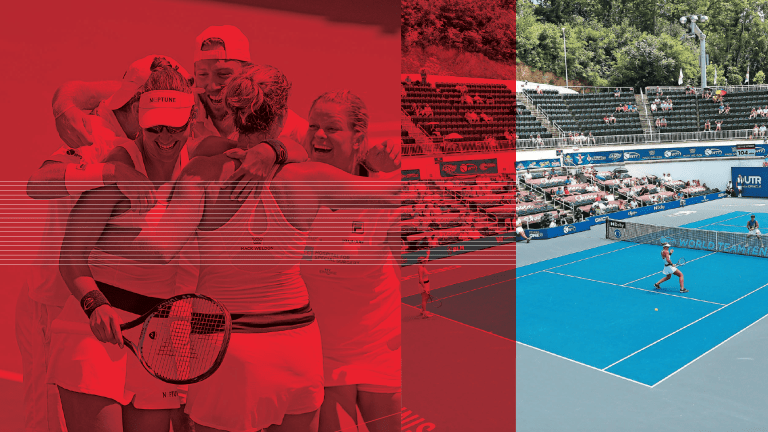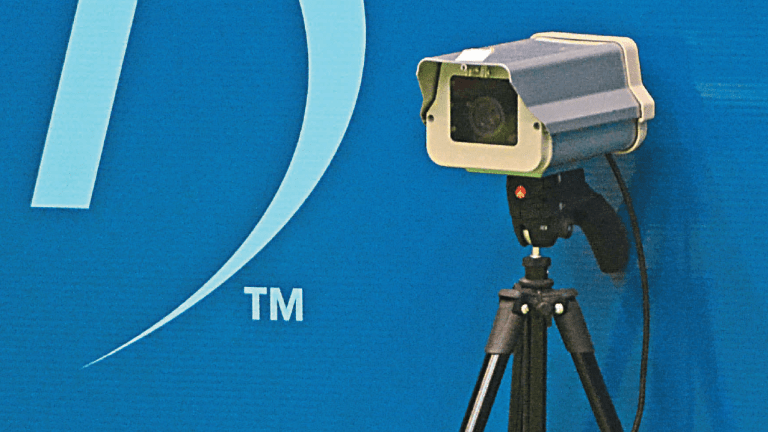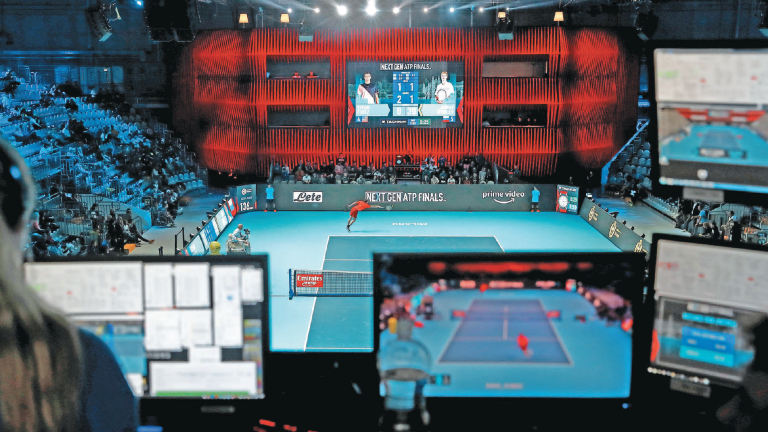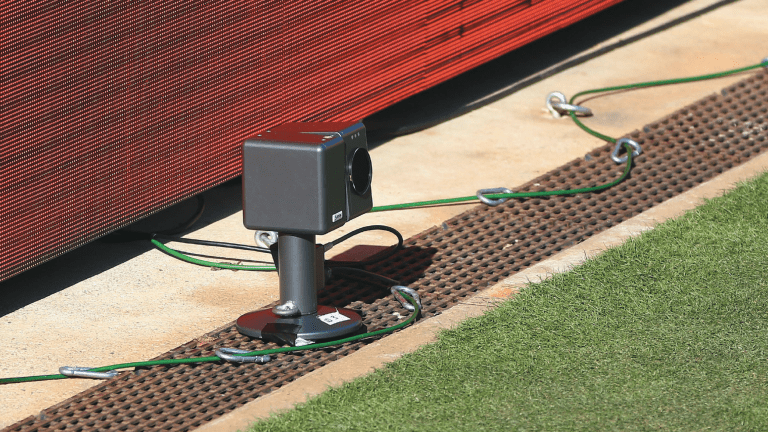"Gets the call right every time": How tennis went electronic
By Steve Tignor Nov 14, 2020Roger Federer and Caroline Wozniacki step out at the Masters: “So much tradition”
By Baseline Staff Apr 13, 2025Richard Gasquet given Monte Carlo wild card 20 years after breakthrough win over Roger Federer
By Ed McGrogan Apr 03, 2025Wolfgang Puck: The biggest tennis fan in the kitchen?
By Mitch Michals Mar 12, 2025Serena Williams, Roger Federer, Aryna Sabalenka and pickleball all featured during Super Bowl LIX
By Liya Davidov Feb 13, 2025Roger Federer’s Wimbledon-winning racquet sells for more than $100,000 in tennis auction
By Liya Davidov Feb 10, 2025Roger Federer explains tennis scoring, On logo to Elmo in Super Bowl ad
By Baseline Staff Feb 10, 2025Roger Federer’s Wimbledon winning racquet currently up for auction
By Liya Davidov Jan 28, 2025Henry Bernet, Australian Open junior champion, takes inspiration from fellow countrymen Roger Federer and Stan Wawrinka
By Associated Press Jan 25, 2025The best tennis fashion moments of 2024: Federer & Nadal for Louis Vuitton, Kostyuk's viral Wimbledon dress and more
By Stephanie Livaudais Dec 14, 2024"Gets the call right every time": How tennis went electronic
Now that automated line calling has succeeded at a Grand Slam, is there any reason why the sport shouldn’t adopt it everywhere?
Published Nov 14, 2020
Advertising
“We Will Rock You” was blaring from the loudspeakers. Luke Jensen was waving his arms and firing up the crowd. The socially-distanced fans were cheering through their masks. After nearly a month inside a coronavirus-free bubble at The Greenbrier in West Virginia, the 2020 World Team-Tennis season had come down to this: The New York Empire and the Chicago Smash were tied 20–20, and 6–6 in the supertiebreaker, resulting in a sudden-death championship point. Whichever doubles team won it would take home the team title, and $500,000 in bonus prize money.
When silence was finally restored, the Smash’s Sloane Stephens served to the Empire’s Coco Vandeweghe. Vandeweghe sent back a screaming forehand return that seemed, at first glance, to skid across the back of the baseline. Or had it? Confusion reigned as both teams tried to figure out whether they had won or lost. Finally, Hawk-Eye rendered its verdict: The ball had touched the line, and the Empire were champions.
“Imagine if we were using replay there, and one team didn’t have any challenges left?” says Carlos Silva, CEO of WTT. “That’s a half-a million-dollar point. The wrong team could have won, and there’s nothing we could have done about it!”
In this case, there was never any doubt that the call would be definitive, and that the players would see it. Since 2017, WTT has used Hawk-Eye Live, an automated line-calling system created by the same company that handles tennis’ electronic challenge replays. Instead of relying on line judges to make calls, Hawk-Eye’s cameras and computers do the job themselves, complete with human-sounding “out” calls. That means no more overrules, no more challenges, no more linespeople, and, if all goes according to plan, no more arguments between players and chair umpires. Even a young John McEnroe might have felt foolish screaming “You cannot be serious!” into a courtside camera lens.

"Gets the call right every time": How tennis went electronic
Advertising
If you’re a tennis fan who happens to be a technophobe—that is, if you fear that robots will soon be running our lives—this summer may have felt like another sign of the apocalypse. In the battle between man and machine, the machines came significantly closer to claiming a long-awaited victory. Two weeks after WTT finished its season, the Western & Southern Open became the first dual-gender tour event to replace line judges with Hawk-Eye Live. The following week, the US Open became the first Grand Slam tournament to do the same.
Since 2017, Hawk-Eye Live has been used at the ATP’s NextGen Finals in Milan, but it took the pandemic to bring the technology to Broadway. The USTA needed to reduce the number of people inside its bubble at Flushing Meadows, and electronic line-calling was one brutally efficient way to do it. Not quite efficient enough for Novak Djokovic, though. US Open officials, leery of a Hawk-Eye Live failure in a big match, kept line judges on its two main show courts, Arthur Ashe Stadium and Louis Armstrong Stadium. One of those line judges ended up in the line of fire when a frustrated Djokovic blindly smacked a ball toward the back of the court. When it hit her in the neck and she fell to the ground, the world No. 1 was defaulted.
For Silva, a former player who has a master’s degree in computer science, the move to automated line-calling is a no-brainer.
“The speed of the shots has passed a human’s ability to say whether the ball is in or out,” Silva says. “Now that just about everyone is serving 120 [m.p.h.] or more, and people are hitting 100-m.p.h. forehands, we should stop pretending that it’s possible to make those calls.
“The players already rely on the replay system. Now you can just listen to the call, instead of having to challenge and see it.”
As far as reasons for installing electronic line-calling go, the pandemic was an unfortunate one. But there may be no going back for tennis even when life returns to normal. The experiments in the Flushing Meadows bubble were widely considered a success, and the ATP gave the green light for its tournaments to use the technology this fall. James Japhet, managing director of Hawk-Eye North America, told the New York Times that Hawk-Eye Live made 14 errors out of 225,000 calls during the Open’s first week.
“Fourteen is a larger number than we hoped for,” Japhet said. “But all things considered, 14 out of 225,000 isn’t too bad.”
Before the Western & Southern Open, the sport’s most prominent American player, Serena Williams, gave Hawk-Eye Live her seal of approval.
“I think a lot of that will be a huge benefit,” she told reporters. “I think anything electronic takes away human error, which is natural.”
After three weeks with the system in Flushing Meadows, there were few, if any, player complaints.

"Gets the call right every time": How tennis went electronic
Advertising
Using Hawk-Eye Live dovetails with two trends in professional sports. The first is the universal desire to speed up play; any time that is currently lost to the replay-challenge process would be eliminated. The second is the growing desire to employ whatever technology is available to make sure that calls are correct.
Tennis, which went to instant replay in 2006, has been a pioneer in this regard, and has been followed recently by the National Basketball Association and Major League Baseball, which have instituted challenge systems of their own. Gradually, the argument that human error is tolerable, and that its potential unfairness is a price worth paying for the controversy and drama it brings, has lost its persuasiveness. As Silva says, a missed line call can cost a player hundreds of thousands of dollars.
Hawk-Eye Live also has the power to eliminate the one common, problematic scenario that its replay system can’t handle. You’ve seen it a thousand times: A line judge calls a ball out at the same time that a player hits the ball and makes an error; replay then overrules the call, leaving it up to the chair umpire to decide whether or not the call affected the player’s swing. Since all calls should now be correct, that situation shouldn’t arise again.
Still, in a tradition-minded sport like tennis, some will likely be left cold by this emphasis on electronic efficiency. Roland Garros stayed with its traditional system of using line officials and inspecting ball marks this year, and it remains to be seen whether clay events that have long avoided installing a replay system will change their minds with Hawk-Eye Live. It’s hard to imagine clay-court tennis without the sight of a chair umpire and a player hunched over together, pointing at a line, and arguing vehemently over the exact dimensions of an indent in the dirt.

"Gets the call right every time": How tennis went electronic
Advertising
Roger Federer, who has never been a fan of electronic replay, has expressed a desire to keep line judges on the court in the past, and not rob the game of one of its human elements. American player Jessica Pegula told the New York Times this summer that line judges are a “fun part of our sport, and obviously adding the challenges in to kind of question them makes it exciting and more entertaining for fans.”
It is also true that, as the 14 missed calls at the US Open attest, Hawk-Eye Live is run by humans who can make mistakes. For instance, foot-faults are called, or not called, by a live official who is monitoring a baseline camera.
Others believe that tennis would hinder its own growth if it removed line judges, many of whom are passionate tennis fans, and who transmit that passion to those around them.
“How much of a tennis fanatic do you have to be to put yourself in the line of fire, however unlikely, for a badly paid job and no thanks?” tennis journalist Richard Evans wrote on Twitter after Djokovic’s default. “And tennis is trying to get rid of these dedicated line judges? So the game can afford to cut the umbilical cord to the [next generation]? Madness.”
Which brings us to the biggest problem with automated line calling: It would put hundreds of people out of work in the middle of what could be a prolonged recession. Line judges are professionals who travel the tour; in a normal year, 800 people would vie for 350 positions at the US Open.
They do a highly pressurized and largely thankless job, and they’re a close-knit fraternity who look out for each other on the road. As Pegula says, they’re also part of tennis’ culture, its combustible mix of human excellence and human error. Would replacing them with an invisible, omnipotent machine make the game run too smoothly, too quietly?
Jeff Ryan, who took over as tournament director at the ATP’s Winston-Salem Open earlier this year, doesn’t think so.
“Challenges, arguments create some drama,” Ryan says, “but they don’t make or break the show.”
Before his late-August tournament was postponed due to the pandemic, Ryan was given the option of using electronic line-calling by the ATP. It was a tempting proposition.
“I think it’s inevitable,” Ryan says, “and people will see it as logical, as the next step in trying to achieve perfection.”
For now, the cost of housing, feeding and paying a full crew of line officials isn’t much different from the cost of installing Hawk-Eye Live on five courts, at $25,000 per court. Both are “six-figure investments,” Ryan says, which is a significant chunk of money for a 250-level tournament like his. But that will likely change as other companies get into the electronic line-calling business, and the price of the technology comes down.

"Gets the call right every time": How tennis went electronic
Advertising
Perhaps more than cost, the determining factor in this contest between man and machine will be the simple knowledge that electronic line-calling exists, that it works, and that it improves officiating. From now on, every time a line official misses a call, a commentator will cry out for Hawk-Eye Live. It happened during the US Open men’s semifinals, when Daniil Medvedev briefly became unhinged after not being allowed to challenge a call that went against him.
“This will be the end of linespeople at the majors,” ESPN’s Patrick McEnroe quickly declared. “[The electronic system] gets the call right every time.”
So technophobes beware: The robots may be coming to the tennis court very soon. The question for some will be: Is the peace they offer worth the human cost? The answer, sooner or later, will probably be yes.